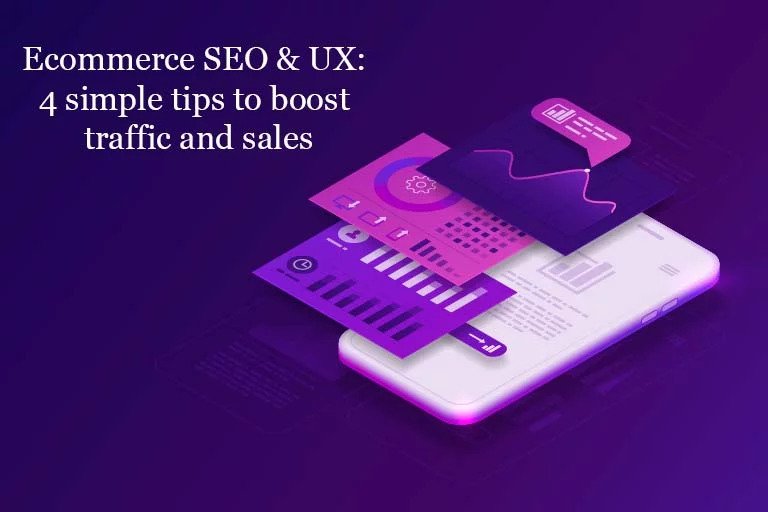UX (user experience design) is becoming an essential component of ecommerce SEO (search engine optimization). Search engines no longer analyze web pages based on keyword use. Instead, to score highly in organic search engine results, a website must comprehend user intent and deliver a rich user experience seo.
Meaning of Ecommerce SEO
Ecommerce SEO refers to optimizing an online store for search engines. Writing detailed descriptions with relevant keywords on each product page is an example of optimization. Getting backlinks from related websites also helps your online store’s rating. Ecommerce Website SEO is improving a website to rank higher in search engines. The content’s quality and relevancy, proper keywords to optimize the site, and the site’s load speed all impact how high a website ranks in the SERPs.
Managing an ecommerce website SEO entails understanding what technological pieces are required and how they interact with a site’s user experience seo, indexing, and ranking. It entails optimizing keywords and content for seasonality, ranking, and conversions. How social engagement, referrals, marketing campaigns, on-site content, site structure, site code, ecommerce seo, and other factors contribute to SEO health and overall organic sales. But what exactly does this mean?
Assume you sell hiking equipment abroad and have a few categories with many goods in each. You have a website blog and a highly active Facebook page where you post hiking experiences and promotions. You ask people to engage in conversations with your business and each other. We would examine content duplication, business user input abilities, IMC content utilization, traffic-generating keyword use, and other factors. We investigate current performance after determining the baseline health.
We would examine content duplication, business user input abilities, IMC content utilization, traffic-generating keyword use, ux seo and other factors. We would examine content duplication, business user input abilities, IMC content utilization, traffic-generating keyword use, and other factors. We may construct a baseline mark to compare with throughout time and during improvements by looking at the site’s indexing, ranking, page performance, conversion rates, online reputation, and other variables.
Meaning of UX SEO
UX SEO (user-experience design) is becoming an essential component of SEO (search engine optimization). Search engines no longer analyze web pages based on keyword use. Instead, to score highly in organic search engine results, a website must comprehend user intent and deliver a rich user experience. UX SEO optimization for Site Load Speed enables UX SEO designers and technical SEOs to gain practical insights such as minifying HTML, CSS, and JavaScript and optimizing cache, images, and redirection.
User experience SEO (UX) work hand in hand when designing a high-ranking website. This is an onsite user experience instead of an offsite user experience, which occurs away from your website and is commonly referred to as customer experience. Website User Experience SEO includes everything from a site’s design and layout to how the user interacts. Before the importance of UX in SEO, web designers concentrated on building sites for search engines rather than consumers.
Today, search engines, notably Google, focus on user behaviour to provide the best search results. They examine how users interact with a website; if they don’t like the information, you can bet your ranking will suffer. Pogo sticking is one of the essential UX SEO indications that Google can evaluate. When a person visits a site via Google search, doesn’t find what they were searching for, then goes back to Google, only to be directed to another search result.
Users go through this process several times before visiting a site and never click around.
4 simple tips to boost traffic and sales
Build a Solid Site Taxonomy
Website taxonomy refers to how content is on a website, arranged, linked, and related. Website taxonomy is a framework for a website that organizes content logically so that users may browse and comprehend the site’s purpose, appearing visually as separate parts and pages on a website or categories on a blog. Good website taxonomy makes material accessible, findable, and purposeful to your readers and search engines. It aids in the visibility of products across business domains by highlighting redundancies, dependencies, and value flow. Provides a uniform language for corporate goods, reducing misunderstandings between technology and business. It aids in the classification of species, allowing us to transmit biological information more effectively.
Explore use cases for Product Searches
A use case in UX SEO is a strategy for identifying, clarifying, and organizing system requirements in system analysis. A use case in user ecommerce SEO is a collection of possible interactions between systems and people in a particular environment tied to a specific purpose. The function generates a document that details all the steps a user takes to accomplish an activity. Use cases give a framework for obtaining client needs and defining the project’s scope.
They’re also great for letting end users ‘test’ the system while it creates, resulting in faster development and a more functional design. It offers value since they assist explain how the system should function while also brainstorming what may go wrong. They present a set of goals used to determine the system’s cost and complexity.
Merchandise Your Products
E-commerce merchandising is a science as well as an art. Its purpose is to increase sales by matching customers with the right items. E-commerce merchandising’s most important job is to lead consumers through their customer journeys. Compared to conventional establishments, the consumer journey in e-commerce is more complex. Merchandising provides many additional chances for product marketing in ecommerce. Make sure you have opportunities to cross-sell these items and that they are intuitive with the product they want to purchase.
When you enhance your merchandise and how your items improve the user experience, you increase the number of ways searchers will find you.
Leverage Shopping Deals and Seasonal Promotions
Merchandising also considers how the product is advertised. This would include shelving, shelf signs, aisle signage, floor signage, packaging, price labels, and promotional pricing labels in a physical store. Shopping discounts and seasonal promotions are also available in ecommerce seo.

